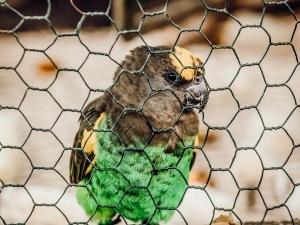
Cages are safe and comfortable structures but you shouldn’t keep your bird in these all day, birds need to be let out from time to time.
If you want to let your untamed bird out of its cage, there are a few things that you need to know and keep in mind:
Table of Contents
Benefits of letting the bird out:
Physical stimulation:
As large as your bird’s cage may be the cage is still a cage and the bird can only fly so far in the cage and the bird can only get so much physical exercise while in the cage.
One reason why you would want to let your bird out of its cage is to give it the opportunity to get more exercise than it is getting while in the cage.
If your bird is let out it would really have the opportunity to spread its wings and fly
Mental stimulation:
Your bird’s cage will get dull and bring to the bird if it is left in there for several hours a day, this is true even if the bird has toys in the cage.
Any enclosed environment can get stale after a while so letting your bird out of its cage will allow it to be stimulated by the world
Letting your bird out will also keep the bird from becoming depressed in the cage
Precautions when letting the bird out:
As good as letting your bird out is, these animals can get into trouble when let out. So to keep your bird safe, you’d need to take precautions before letting the bird out of the cage.
Close close close:
Whether your bird is tamed or untamed birds can get into things that they shouldn’t get into, they can get scared and fly into windows, step on a hot stovetop, fall into the toilet, and get into chemicals in your house.
Keep this from happing by keeping your windows, doors, and toilets closed and switch the stove off before you let the bird out.
Use a harness:
Using a harness is recommended if you’re wanting to take an untamed bird out of the cage.
A harness will allow the bird to fly around as it wants while still allowing you to be in control of the situation so that it doesn’t fly away too far.
This is especially recommended if you’re letting your untamed bird fly out of its cage and outside the house.
Clip the bird’s feathers:
Many don’t agree with clipping feathers but some say that it’s the only surefire way to keep your bird protected and safe, what you do with your bird is your choice.
Clipping entails clipping the ends of your bird’s feathers to keep the bird from taking flight.
A bird with clipped feathers will still be able to fly down from a high height but it won’t have the ability to fly up and fly away.
Getting the bird out of the cage:
The bird should come out of their cages when it is comfortable. Avoid trying to force the bird out of its cage.
Simply open the bird’s cage door and allow the bird to come out of it wants to. If the bird does not come out when you open the door you can close the door after an hour and try again tomorrow
If the bird has never been let out of its cage then it may be quite nervous about doing this and may be scared of the situation.
Allow the bird to get used to the door being open and then the bird will come out on its own likely sitting on top of its cage and then flying out.
How to get the bird back in the cage:
If the bird knows that its cage is its only source of food and water then the bird will eventually tire of flying around and will what to go back to its cage to eat and drink.
If the bird isn’t going back into the cage you can leave extra treats inside the cage and allow it to come get the food when it becomes hungry.
If the bird still does not get into the cage you can catch the bird, and put it back in its cage. Do this without chasing it, be sure to approach it slowly and carefully.
If you enjoyed this article then you may also be interested in other bird related articles. Here are some articles that you may be interested in: How To Stop Cage Aggression In Birds, Parakeet At The Bottom Of The Cage Fluffed Up, Budgie Flying Around Cage At Night, Budgie Bullying Other Budgie

